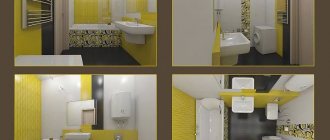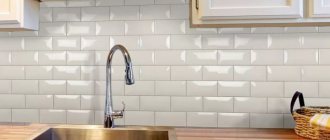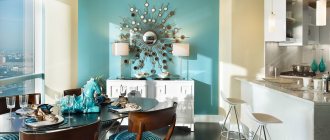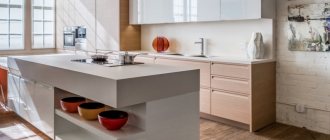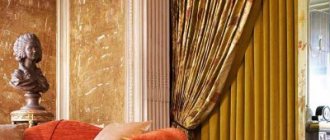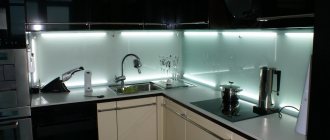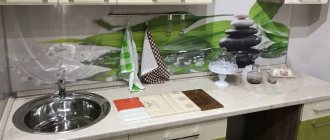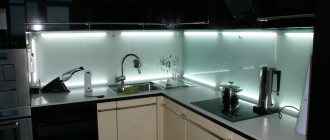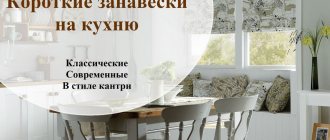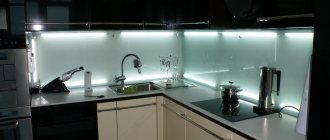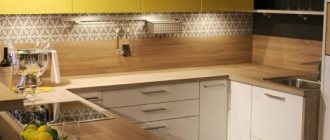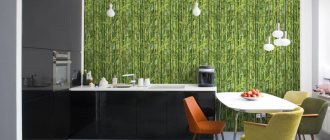A modern kitchen backsplash can be completely unique! You have a choice between dozens of popular materials, hundreds of prints and millions of shades. Designers advise first of all to select a specific option for the kitchen set, its style and facades.
But it is also worth considering the lighting of the room, floor finish, type of interior doors and even the color of household appliances. In our article you will learn exactly how professional interior designers select different apron options for the kitchen. We will reveal all their secrets.
Fashionable cladding is often composed of several colors and has an ornament
Peculiarities
We are not talking about a housewife's overalls in the kitchen, even if the purpose is almost the same.
An apron is a covering over the work area that protects walls and furniture from steam, high temperatures, drops of grease and food. To adequately cope with this task, for its construction it is necessary to choose a material with good characteristics that does not deform over time and can also be maintained. Although some designers choose to use trim throughout the entire wall, more often the backsplash stands out from the overall composition and serves as a striking detail using color, texture or pattern. You can buy the same finish as the countertop to harmonize the space.
Dark surfaces are considered less practical. But if the backsplash is a rich color, the rest of the room should be "muted." Horizontal stripes will help visually stretch the room, and mirror finish will add volume. Colorists recommend using warm shades, as food looks more appetizing against the background.
But these recommendations are very conditional; you need to go beyond your design skills and tastes, since the range of materials is quite wide.
Tempered glass apron
As soon as they appeared on the market, glass splashbacks immediately became the favorites of interior designers. We are talking about options with photo printing, which are called skinali and look incredibly impressive.
For the production of aprons, impact-resistant tempered glass, up to 8 mm thick, is used. It is not afraid of high temperatures and mechanical influences, but if, after making an effort, it is broken, the glass breaks into harmless fragments with rounded edges.
Today there are different types of tempered glass kitchen aprons on sale:
Transparent apron. The purpose of its installation is to additionally protect the existing finish from splashes of water and grease. If this option seems boring, you can order frosted glass or a texture, such as satin or sandblasting. Such solutions are found when decorating doors in shower stalls.
Transparent glass apron.
Plain (painted) apron. The paint is applied from the inside and undergoes heat treatment, so it does not lose its brightness throughout its service life. The number of color variations amounts to thousands of shades to suit every taste and every interior.
Plain glass apron.
Apron with UV printing. Using a special printer, an image is applied to the inner surface of the glass, and which one depends on the imagination of the designers. Under the influence of UV radiation, the picture freezes, impressing with its depth and expressiveness.
Apron with UV printing.
Design options for glass splashbacks
Each type of glass kitchen apron is good in its own way; the choice depends on the personal preferences of the owners.
In what case is it better to use
If you are going to decorate a kitchen in a Scandinavian style, you like neoclassicism, minimalism, hi-tech and other modern interiors, glass splashbacks are what you need.
Advantages of glass aprons:
- Strength.
- Hygiene.
- Thermal resistance.
- Infinitely large selection of design variations.
- Easy to clean like any glass.
Disadvantages of glass aprons:
- Careful alignment of the wall and additional finishing are required if the glass is transparent;
- Any technological holes are laid during production; it will not be possible to drill glass, for example, for roof rails;
- Water marks and dirt will be noticeable on the surface of the apron, so you will have to keep it clean, especially if sunlight falls on the glass.
As for skinals, they are so amazingly beautiful that they produce a wow effect even on people who are indifferent to interior design. At the same time, aesthetes and adherents of noble classics consider such aprons tasteless.
Technical features when choosing an apron
When choosing an apron, the size of the room is of great importance. The larger the kitchen, the less equipment there will be on the countertop, and on the apron you can choose any ornaments and small motifs. If the area is small, be prepared for the entire table to be filled, and the apron itself to be covered with railings and objects on it. As a result, he will have minimal or no designs.
Apron size range
The height of the apron varies from 50 to 65 cm; determine this parameter yourself, starting with what will be most convenient. Everyone's height is different, and height preferences also vary. If the hood is domed and not built-in, the trim must be extended by another 20-30 cm.
This is an important point if you want to order tempered glass, which will cost more. Or, if you prefer, cover the piece with another material before pulling it out and attaching it nicely to the glass.
The apron must run along the entire perimeter of the kitchen unit, and not just behind the hob and sink. First of all, it's cuter. And secondly, in these places there is always a danger of getting dirty or dirty with splashes of grease. And if there is no material that is easy to clean, all the beauty of the kitchen will fade in a year at best. If the sink is in a corner, extend the apron to the adjacent wall; this area is always the dirtiest.
A few more tips
The most popular materials for protective sheeting are tiles and skins. To begin with, we will indicate the optimal height of a backsplash in a tiled kitchen: the standard is 60-65 centimeters. However, the standard is the standard, but the individual features of the kitchen should not be overlooked. Now we will talk about the traps that lovers of wall tiles can fall into when calculating the parameters of the apron.
Risk one: uneven walls and floors
It's no secret that even in new buildings the walls and floors are sometimes far from being perfectly even. But even a seemingly insignificant error of 0.5 cm can ruin the entire appearance of the kitchen ensemble. Even a small gap that reveals a bare wall defeats all efforts to create an elegant design. It’s even worse if a strip of wallpaper comes into view. After all, over time, it will take on a deplorable appearance under the influence of temperature and steam. Remember: the more fashionable the kitchen is furnished, the more cartoonish the mistakes in its decoration look. Therefore, when calculating the height of the apron, do not be lazy to take measurements in several places. If you are not confident in your own abilities, invite a professional measurer and place an order according to his information. This is the only way to achieve the ideal dimensions of a tiled kitchen splashback - size, height, configuration behind the hood.
Materials for an apron in the kitchen
What are they and what to choose:
- Ceramic tiles
- Glass
- Made from the same material as the tabletop: laminated MDF or chipboard (postforming)
- Mosaic
- Plastic
- Photo frames, etc.
Only the first 3 are reasonable modern options. They meet all the requirements of sustainability and practicality, and the number of variations in appearance tends to infinity.
The photo card is of poor quality and leaks on the glass. Plastic looks cheap and bad, you can always find cheap tiles that still look much better than plastic.
Ceramic tile
Let's compare tiles with glass. Tile characteristics:
- Huge selection of sizes, colors and textures.
- Unlike glass, it can have a deep texture, which means it will look much cooler under lighting, which is almost always built into upper cabinets.
- The downside is the seams between the tiles, which is not so important if you know how to choose a tile grout, but still.
Phototile
Full photo printing on the tiles leaks onto the glass apron. If you want a design, you can order any one and place it under glass. If we were talking about large areas, like a bathroom wall, then yes, it might make sense in photo tiles, but not on a kitchen backsplash.
One of the advantages is the ability to make a drawing yourself, so that it is clear that the drawing is yours and unique. With a glass shell this is also possible, but your work with tiles is perceived as more interesting.
Glass aprons
Skinali made of tempered glass is a perfectly smooth and durable material for finishing an apron. Depending on the transparency, there are two options for glass surfaces: matte and glossy. And most importantly, under the glass you can place any image that you find on the Internet with sufficient resolution.
Although my advice is to do color, not a photo or drawing. During use, there will be many objects that will disrupt the composition, and initially you may make the wrong choice.
Such options without drawings are standard for high-tech kitchens.
In terms of practicality, glass competes with tiles:
- Easy installation for the customer: go to one place and order everything turnkey.
- The smooth, non-porous surface is not suitable for dirt. Even if you don't clean for a long time, you can always wash it back to its original condition.
- Unlimited possibilities - any image and photo.
- Forgive the lack of texture variation - a smooth surface is very practical, but a deep texture can look very beautiful (especially in lighting).
The disadvantage of glass on the apron is the price. Skinal averages $30-$60 per linear foot, which is comparable to the price of quality tile. The price is adequate, because in all respects they compete on approximately equal terms.
Stone apron
Stone as a facing material comes in two types: artificial and natural. The second option is used much less frequently, mainly due to the high cost, which does not correspond to the duration. But to ensure maximum environmental friendliness of the cladding, you can buy porcelain stoneware slabs. They are quite strong and durable.
Marble looks very noble, but when exposed to moisture it quickly loses its attractiveness. Rational owners prefer artificial analogues. Acrylic and quartz products do not absorb moisture, do not deform, and are also excellent for decorating countertops of the same shape.
A plaster apron can be considered on par with the previous options if a protective varnish is applied. Designers do not recommend combining different types of stone in one space, especially in modern interiors.
Regardless of the origin of the material, its cost is higher than that of other products, and installation requires the intervention of professionals.
Steel apron
This element will fit perfectly into the interior of a kitchen in the style of hi-tech, loft or minimalism, but if you wish, you can choose a suitable option for classical trends. In general, a steel apron is still considered something exclusive. It gives the room a strict, elegant, even “official” look, which is why metal is often combined with “warm” wood.
Aprons are made from affordable stainless steel and more expensive copper. The texture can be different: glossy, mirrored inside, or matte, forming a soft “glow”. A sheet of metal can cover the entire free area so that it does not form seams and creates a feeling of solidity.
The work area will look even more impressive if special lighting is installed above it - the light from spotlights directed at the steel sheet glows beautifully in the evening.
Kitchen apron made of MDF and chipboard (postforming)
In general, it could be made from acrylic, but this is not economically feasible. But chipboard in terms of price/quality ratio is quite sufficient.
MDF and chipboard for the apron are used for both facades and countertops. Postforming is a wood-based adhesive laminated on all sides with durable plastic. Countertops are made using the same principle. Peculiarities:
- Simple installation without preliminary leveling of the walls.
- Equally easy disassembly if necessary.
- Ease of maintenance.
- The ability to accurately implement suspended ceilings or facades in color and texture.
- Economical both in price and in appearance.
Porcelain stoneware apron
The composition of porcelain stoneware includes two types of clay, quartz sand, silicates and coloring pigments. Each ingredient improves the characteristics of the material and also increases visual capabilities.
Due to the cost and complexity of installation, porcelain tiles are often used to finish the entire wall, but where a particularly durable coating is required, you can limit yourself to just an apron.
This type of coating is good because it can be used to imitate any other material: for example, for engraving the texture of wood, which is less resistant to kitchen conditions, or expensive marble.
Brick apron
Brickwork is incredibly popular not only in the loft, but also in other interiors. At the same time, it is not necessary to use rough brick for finishing - you can create the desired texture using more practical materials that will cope with the role of a kitchen apron.
An elegant solution is a brick-look apron made of ceramic tiles. You can choose a glossy or matte texture, and you can choose a custom color scheme. Artificial stone also has the desired effect, but it is recommended to worry about its preparation in advance.
If there is no need to imitate brickwork, then natural brick is suitable for decorating the work area. It is resistant to extreme temperatures, is quite durable and does not require maintenance. Before purchasing, make sure that the surface is not rough, otherwise it will quickly absorb all kinds of dirt.
Mosaic
This option looks very interesting and relevant, but there is a serious nuance to it. Mosaic involves a huge number of seams. If an ordinary tile has 1 horizontal and 3-5 verticals, then a mosaic has hundreds of seams.
Therefore, using a regular shoot for a mosaic on an apron is a so-so option - it will very quickly lose its appearance. What remains is epoxy-based grout, but it is very expensive, you will need a lot of it, and not all craftsmen know how to work with it. Therefore, you will either have to fork out more money, or it is better to abandon the mosaic idea.
But there is an alternative version of the apron - pseudo-mosaic. This is a tile that externally imitates a mosaic in texture and pattern. Mosaic tiles will be much cheaper, the seam area on it will be ten times smaller, and this is important for a backsplash. If the tiler is experienced and the color of the grout can be accurately matched to the color of the false joints on the pseudomosaic, there will be almost no visual differences.
Mirror apron
Mirrors are the rarest material for a kitchen apron, although they can look luxurious. An option is a mirror with a bevel, but we are talking about a luxurious look; cooking in such a kitchen is problematic - cleaning will take just as much time.
Be careful when choosing mirrors for your work apron, as a reflective surface doubles the clutter on your desks. To avoid this feeling, you must always keep the kitchen perfectly clean and not leave unnecessary items on the surface. Of course, you can forget about roof rails.
If you want glare and light, it is better to use glossy tiles or glass; mirrors are only suitable for a kitchen that is not used for its intended purpose at all.
Oilcloth
Yes, an apron can also be made from oilcloth. One of the cheapest options you can do yourself. All you need to do is take the necessary measurements, choose the oilcloth itself, and then attach it to the wall using a furniture stapler.
This option will protect the walls from dirt and water, but for a gas stove it is better to choose another option - the oilcloth can char.
Choosing which apron is best for a given situation is not easy. Most often, people are guided only by aesthetics, but do not forget about other points:
- balance;
- planned duration of use;
- kitchen style;
- difficulty of repair and replacement;
- cleaning.
Focus on these factors, and your apron will delight you for many years.
Plastic apron
A plastic apron is an inexpensive option for finishing a working wall in the kitchen. The plastic panel has a modern look and is easy to assemble. In photographs it is impossible to distinguish it from glass skin, but in real life it looks downright worse. If you have financial problems, it is best to consider the postforming option.
The most noticeable accent in the interior can be a kitchen apron, which, due to its small area, is not worth spending a lot of money on. The 2 best modern options are glass and tile.
Artificial stone apron
A fashionable finishing material based on polyester resins with the addition of stone chips is produced under the name artificial stone. It looks quite realistic and noble, but weighs much less than its natural counterpart.
An artificial stone apron is usually made together with a countertop. During installation, they are monolithically glued together without forming seams. This feature of the installation and the absence of pores in the structure of the material eliminates the accumulation of dirt and the proliferation of microbes.
Design options for artificial stone aprons
In what case is it better to use
This type of kitchen apron will appeal to lovers of non-standard interior solutions and fans of the classic style. Classics and stone, even artificial ones, combine perfectly; the wall and table surface look rich and noble, especially in addition to wooden facades.
Advantages of an artificial stone apron:
- Hygiene.
- Absolute protection of walls from moisture.
- Impeccable appearance.
- Strength, durability.
- Defects acquired during operation can be easily eliminated by grinding.
Disadvantages of an artificial stone apron:
- A small number of color and texture solutions compared to other types of finishes.
- Quite a high price.
- Labor-intensive, responsible professional installation.
The disadvantages of this option for wall design are offset by the service life, calculated in decades.
Materials for the original apron
So, the main ideas ended with how to design an apron. In addition, there will only be very original options.
Discs and glassware fragments
This is where all the necessary and unnecessary junk comes into play: broken slabs, whole slabs, disks - all this is glued to the base, and tile grout. It looks impressive, because it is simply impossible to find such a second apron.
But here too there is a problem with the seams, which will have to be cleaned frequently. In addition, CDs have a mirror surface, on which all drops and dust particles will be visible.
Slate
A very original method is to make a slate board instead of an apron. All you need to do is go over the required space with slate paint three times. It is easy to care for - avoid using abrasive cleaners and hard sponges.
With the help of drawings on the board, you can change the appearance of the kitchen every day - you definitely won’t get tired of it. It will look especially impressive in a white kitchen.
Pebbles
If you are a fan of pebble beaches, then such a corner can be created in the kitchen. For example, in the form of an apron. But since the surface of the stone is uneven, it will be very difficult to clean it, dust will get between the stones, and as a result, such a panel will quickly lose its original appearance.
Wine corks
Yes, too: they smear wine corks on their aprons. Moreover, they not only collect them themselves, but also buy them from bars and restaurants. To speed up the process, cut them in half to make it easier to stick to the backing.
The laying pattern is the same as for parquet. Only the material of the caps is porous, so washing them will be a big problem. You can resort to a constant assistant - glass, but is it worth building an apron that is already thick? The wine stopper idea is suitable for the dining area, but for the work area in the kitchen.
Laminate or parquet
Laminate is preferable to use on an apron, and even more often it turns out to be cheaper than parquet. It is worth choosing high-class material (32-33) and good locks with moisture protection. You will have to install it yourself, since ready-made laminate panels for the apron are not sold. Sticks to liquid nails.
The apron for parquet is made differently: first, the “matrices” are glued to the support using glue or liquid nails, then everything is painted and also attached to the wall. But the paint may melt or crack on the stove, so this method is not suitable for everyone. You can cover the parquet with glass, but then the apron will turn out to be too thick - this is not suitable for everyone. But it looks very original.
Apron made of wooden boiserie wall panel
From the palaces of the French aristocracy, boiserie migrated to our houses and apartments, including kitchen aprons. These are wall panel modules made of natural wood that resemble clapboard and are mounted in a groove. Boiserie can decorate the wall above the tabletop on its own or in combination with stone.
Design options for aprons made of wooden bowser panels
In what case is it better to use
In rustic interiors, especially Provence, this type of kitchen apron looks great, cozy and harmonious. If you are attracted to provincial motifs or eco-style, it is interesting to experiment with boiserie installation.
By the way, boiserie panels are used to decorate not only the work area, but also all the walls in the kitchen, especially if it is a kitchen-dining room. Often the installation is carried out to the middle of the wall, separated by transverse lamellas and continued higher.
Advantages of a boiserie apron:
- It looks cozy and original.
- You can always change the shade by tinting or “aging” it with patination.
- Few people have such kitchen aprons.
Disadvantages of a boiserie apron:
- Wood is hygroscopic, fire hazard and absorbs odors, so the panels will have to be periodically impregnated with special compounds.
- For the same reasons, it is not recommended to install them behind the sink and stove.
- It is quite difficult to clean the seams between the boards from dust and dirt.
Fragmentary installation of boiserie is an interesting idea that deserves attention, but sewing up an entire apron with them is not particularly practical.
Requirements for apron material
When choosing modules in the catalog of kitchen aprons, you need to pay attention to the characteristics of the selected material. The basis for creating a protective coating on the hob must meet a number of requirements:
The area of the apron, even in large kitchens, rarely exceeds 2 square meters. This way you can buy expensive, cool tiles and give your backsplash a really classy look. It’s stupid to miss this opportunity: choosing more expensive facades or countertops will cost a lot of money, but it’s quite possible to spend money on 2 meters of apron.
Tiles with imitation wood, concrete and marble look beautiful, but only with imitation and texture, and not just with a pattern.
White pork is also still in vogue and is likely here to stay. It looks too elegant in both classic and modern styles. There is no risk of looking bad - white pork is the most common and proven option.
- Strength of the material. Robust design makes the material resistant to mechanical deformation.
- Moisture resistant. The presence of an apron implies frequent cleaning of the work area, which means the upholstery does not have to be afraid of moisture.
- Resistant to high temperatures. Heat from the stove can damage some of the materials used to make backsplashes.
In addition, they pay attention to the appearance, presence of decorations and environmental indicators. The production technology must not use toxic or flammable paints and varnishes.
Comparison of different materials
The material from which the kitchen apron is made is selected depending on what the customer considers to be the key parameters
- practicality and ease of care
- moisture resistance
- high temperature resistance
- self-assembly and disassembly
- durability
- appearance
- cost of materials and installation
The cheapest option is to line the kitchen working wall with plastic, MDF or laminate. Mosaic, stone and Italian ceramics are the most expensive options.
Glass, metal or mirrors are creative options, but you must be prepared to keep them clean. To make a kitchen screen both practical and beautiful, finishes are often combined.
An interesting solution is to cover the stone or pebble apron around the stove and sink with glass panels. Another option is a combination of ceramics in active cooking areas and MDF above the dining area.
Color composition for an apron
The color scheme plays an aesthetic role in the interior of the kitchen. A variety of shades can either emphasize or spoil the overall design direction of the room. Therefore, the choice of color is approached from a practical point of view.
Natural shades for an apron
A chocolate, wood or walnut shade of an apron is used to decorate a white kitchen. The combination of dark and calm tones and snow-white furniture has a beneficial effect on a person’s mood and psychological state.
Blue and red colors
Rich colors are used to decorate kitchen aprons in light interior models. Bright colors allow you to highlight one or another area of the kitchen and emphasize the original decor of the set.
White color for apron
All shades of white - cream with a bluish tint, cream with pink notes - are used in contrast with dark colors. Most often, such compositions are used for high-tech and Scandinavian kitchens.
Rules for choosing a shade
How to choose the color of an apron for the kitchen? Experts advise starting from the shade of furniture, walls, floors and ceilings. What color material to choose depends on many factors. In itself, it is already an independent element and should fit harmoniously into the overall look.
Combination with headset
The area near the hood looks attractive when selected and repeats the shade of the façade of the set. The rest is a neutral tone. How to choose the right material depends on the countertop. They can be made of the same material, such as stone, or similar in texture and tone.
Finishing in different styles
Analysis of a specific direction helps you make your choice. Each style has its own characteristics that must be taken into account to understand which apron to choose.
An apron for a classic kitchen should be plain and match the color of the front side of the set. If the furniture is dark in color, the wall decoration becomes light and vice versa. A white kitchen enhances the contrast so all colors appear brighter.
Country music is reminiscent of a farm ranch, so stone, wood or imitation natural materials are chosen. Provencal style, on the contrary, involves the use of light colors and small elements. Mosaic, light tiles, MDF panels or glass are suitable here.
When decorating a room in a modern style, the cladding can be done with rough plaster, sheet metal, brickwork or imitation wood.
Color Tips
When deciding which apron to choose, room designers give their recommendations:
- materials for white are easier to collect. An apron for a white kitchen should be chosen in light colors. This will make the space lively and fun.
- If the room is dark, the decoration should be as light as possible. This technique will transform the room.
- The option of dark tones is considered inappropriate, since all the drops, dust and stains will be clearly visible on it.
- Muted shades of red and chocolate are suitable for a beige kitchen. To prevent the walls from merging with the furniture in one place, use opposite color options.
- Which is better for red, yellow or orange kitchens? Here you should use a calm neutral color on the wall. To create contrast, the wall is made completely white or black. But it is worth considering the features of the general design.
- A green or blue surface initially looks bright, so tiles or other coverings should set it off while maintaining the overall style. Don't forget about the combination of warm and cold shades.
- For a brown set, a light-colored glossy finish or brick style is suitable.
- Almost any option is suitable for a gray kitchen. The main thing is that warm tones should be combined with warm ones, and cold ones with cold ones. The glass cover with photo printing will help to break up the mouse-colored earphone.
- An apron for a black and white kitchen should repeat one of these tones or be bright. The trend is red plastic or discreet brown tiles.
- If you need to highlight the set, the wall should be made in neutral colors. In a room where there is a lack of expression, the wall in the work area should be highlighted with fancy upholstery that contrasts with the furniture.
When choosing a surface finishing material, it is important to adhere to the same style and combination with the work surface. View all kitchens
Choosing a color
A kitchen apron, in addition to protecting walls from grease and dirt, also serves a decorative function. It can be either neutral, harmoniously fitting into the overall interior design, or a bright spot that catches the eye and lifts the mood.
Neutral
It does not attract attention, it is a purely functional element. As a rule, it is matched to the tone of the furniture set or to the tone of the walls. Beige, milky, tea rose and champagne colors are also acceptable for creating a neutral apron.
Contrasting
Looks great in an interior designed in a minimalist or Scandinavian style. It can either highlight the color of the headset or draw all the attention to yourself. If the walls, furniture and curtains are made in the same color scheme, a kitchen apron, the color of which is a couple of tones different from the main tone, can dilute and enliven the interior.
Bright
Creates a mood, but is not suitable for everyone. Requires the use of bright details of the same color in the decor (towels, fittings, baseboards). However, remember that even the slightest mess will be noticeable against the background of a bright wall.
Apron-decoration
To create an apron, you can use a mosaic, a thematic panel, skins with a photo print or a painting by your favorite artist, or decorative tile inserts. In this case, the main thing is to accurately calculate the amount of material, because it will be very disappointing if part of the plot panel turns out to be hidden behind the cabinets.
Selection rules
When deciding which apron to choose, some details are taken into account:
- It should be in harmony with the overall interior, not be faded or unspectacular.
- When choosing a shade, preference is given to moderate tones. Bright things quickly tire your eyes.
- To make the shade brighter, use glossy finishes. The matte finish looks pale.
- A large print in a large room may get lost or seem inconspicuous; in a small room it may be too voluminous.
- To visually expand the space, draw a horizontal line along the perimeter of the wall.
- A glass or mirror kitchen apron will make the room visually larger. But it gets dirty quickly and requires special care.
- When finishing with tiles, you should choose a square-shaped material (the size can be any). Looks more aesthetically pleasing.
- Tiles should be purchased at a premium. This is due to the fact that it is quite fragile; if handled carelessly, cracks and chips may appear on it. Moreover, products from different batches may differ in shade.
- Smooth surfaces are easier to maintain, as dirt accumulates even on the smallest imperfections.
Mosaic apron
The mosaic wall in the kitchen work area looks bright and original. However, many are stopped by the supposedly painstaking installation of small elements. In fact, this type of kitchen apron consists of blanks, usually 30 x 30 cm, which greatly simplifies installation.
The basis of the workpiece is a mesh onto which the mosaic is attached at the factory. Mosaic elements come in square, round, pebble, shell and other interesting shapes, not to mention colors.
Mosaic blanks are glued with tile adhesive; there is no need to be tricky with leveling the walls. But it is better to use epoxy grout; it does not absorb dirt and does not darken over time.
Mosaic apron design options
In what case is it better to use
Fans of colorful decors and ethnic motifs will definitely like this type of kitchen apron.
The size of the kitchen is not important, but it is worth considering that such a kaleidoscope will make a small room even smaller.
Advantages of a mosaic apron:
- You can choose from ceramics, glass, metal, stone, wood, or combine blanks from different collections.
- A mosaic apron is not afraid of moisture, especially if the seams are protected with epoxy grout.
- Good heat resistance allows you to lay mosaics on the wall behind the slab.
- No special skills are required to install mosaics.
Disadvantages of a mosaic apron:
- Epoxy grout is expensive and you will need a lot of it.
- The surface of the walls and seams will require careful care.
Considering that a mosaic apron will last about 2 decades for clean owners, investing in grout pays for itself.
Installation of a kitchen apron
The decision on how to install the lining depends on the selected material:
- Surfaces such as stone, decorative shawls or mosaic designs require more than just expert help. In this case, leveling and plastering the walls will become a mandatory stage of repair work.
- For panels made of plastic, MDF and some types of tiles, no pre-treatment is required.
In other cases, the amount of preparatory work will depend on the quality of the wall cladding, the presence of structural defects and the presence or absence of a complex pattern on the apron.
The apron above the hob is an extremely important element of the kitchen interior. Decorative coating not only performs a practical function, but also plays an aesthetic role, emphasizing the features of the style.
Laminated wall panel backsplash
Chipboards, better known as chipboards, are a good basis for making budget types of kitchen aprons.
To make the material resistant to moisture and temperature, it is laminated, that is, the slabs are finished with a polymer film impregnated with melamine resin. The resulting material is called chipboard. Chipboard lined with plastic has the same properties.
Chipboard with a thickness of 8-10 mm is suitable for a kitchen apron. Thicker slabs are used to make furniture.
The front surface of the material comes in a wide variety of colors and can imitate any texture, stone, for example, or wood.
Design options for aprons made of laminated wall panels
Apron made of laminated chipboard to look like stone.
Wood-look chipboard apron.
In what case is it better to use
If you want to quickly, cleanly and inexpensively tidy up the wall between the countertop and cabinets, consider that you have found the optimal type of kitchen apron. This option is suitable for renovations in your own or rented apartment, when you want to save time, money and nerves.
Advantages of a chipboard apron:
- Does not require careful leveling of walls as for tiles.
- Simple installation without the involvement of specialists.
- Presentable appearance of the finish.
- Resistance to humidity, heat from the stove.
- Good mechanical strength.
- Large assortment of decorative design of slabs.
- Low price.
Disadvantages of a chipboard apron:
- The finishing belongs to the must-market category, so no matter how much you want, it will not look rich and original.
- The durability of the apron depends on the quality of installation. Particular attention should be paid to the tightness of the joints in the corners, using special corners and if there is no edge, the edges of the apron should be sealed with sealant.
All this applies to chipboard with improved performance, that is, laminated or coated with plastic. Chipboard aprons should not be left in place , otherwise they will not be washed later. This is also a minus. But with proper attention, the finish will last in its original form for at least 10 years, and this is a big plus.
